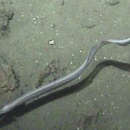en
names in breadcrumbs


Nettastomatidae, the duckbill eels or witch eels are a family of eels. The name is from Greek netta meaning "duck" and stoma meaning "mouth".
Duckbill eels are found along the continental slopes of tropical and temperate oceans worldwide. They are bottom-dwelling fish, feeding on invertebrates and smaller fish.[1] They are slender eels, up to 125 centimetres (4.10 ft) in length, with narrow heads and large, toothy, mouths. Most species lack pectoral fins.
About 40 species are placed in seven genera:
 Duckbill eel from 2017 NOAA Okeanos expedition at a depth of 2,600m (8530ft)
Duckbill eel from 2017 NOAA Okeanos expedition at a depth of 2,600m (8530ft) Nettastomatidae, the duckbill eels or witch eels are a family of eels. The name is from Greek netta meaning "duck" and stoma meaning "mouth".
Duckbill eels are found along the continental slopes of tropical and temperate oceans worldwide. They are bottom-dwelling fish, feeding on invertebrates and smaller fish. They are slender eels, up to 125 centimetres (4.10 ft) in length, with narrow heads and large, toothy, mouths. Most species lack pectoral fins.